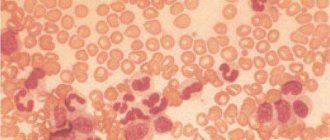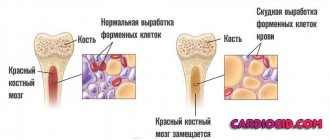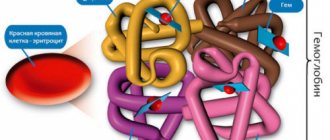Why is albumin needed at all?
Blood is mostly made up of proteins, which also make up hemoglobin. Albumin makes up about 55% of all proteins in the blood, as well as in the cerebrospinal fluid. It easily binds to micronutrients, as well as formed elements, facilitating their normal transport through the circulatory system .
In addition, in the membranes of almost all cells of the human body there are mediators that react to albumin. It is thanks to this that the body regulates the process of intercellular metabolism, allowing cells to receive micronutrients from the blood, including oxygen (and also transfer carbon dioxide to hemoglobin cells for subsequent removal from the body as an excess waste product).
Why is low albumin dangerous? The fact is that the body simply will not receive micronutrients, although they will be present in food. At the same time, the viscosity of the blood plasma is also disrupted, which increases the final acidity of the blood.
Albumin analysis. What does a deviation from the normal level of albumin in the blood indicate?
You should know when donating blood for albumin that this is a substance whose content in the bloodstream varies among people of different ages. Blood test for albumin, the norm is as follows by age category:
- children under 7 years old – 25-50 g/l;
- children from 7 to 14 years old – 38 – 54 g/l;
- children over 14 and adults – 33 – 55 g/l;
- elderly people after 60 years – 34 – 48 g/l.
When determining albumin excreted in urine, the norm is no more than 30 mg in a daily portion of the material. In some cases, a special albumin/creatinine indicator is determined in a single (random) portion of urine. Correction for creatinine level eliminates inaccuracies in the result due to uneven drinking regime. Then the norm for albumin/creatinine is: 17 mg/g for men and 25 mg/g for women.
If the test result shows a deviation from normal values, increased or decreased albumin in the blood or urine, only a specialist can determine what it is. Such results do not always indicate pathological processes, since the level of the protein in question can vary due to physiological factors.
For a more accurate diagnosis, another indicator is determined in a blood test - the albumin-globulin index, which shows the ratio of the amount of albumin to globulins (globulins are another type of protein produced in the liver). The index norm is 1.5-2.3.
The condition when albumin is elevated is called hyperalbuminemia. Often this is a correctable temporary phenomenon associated with dehydration of the body to varying degrees (due to low fluid intake, diarrhea, vomiting). In addition, large numbers may indicate an abundance of protein foods in the diet or excessive exercise. The pathological causes of this condition are:
- intestinal obstruction;
- autoimmune pathologies (lupus erythematosus, Crohn's disease);
- endocrine pathologies (diabetes mellitus, thyroid disorders);
- burns;
- cholera;
- dysentery;
- cirrhosis or hepatitis of the liver.
If albumins are low (hypoalbunemia), in the absence of pathologies, this phenomenon is observed in pregnant women and nursing mothers, during prolonged fasting or following a low-calorie, protein-free diet. Diseases accompanied by a decrease in plasma albins:
- tumors (malignant and benign);
- leukemia;
- blood infections;
- diseases of the urinary system;
- liver diseases;
- liver or kidney failure;
- heart failure;
- rheumatism;
- arthritis;
- large blood losses.
Detection of an increased content of albumin fractions during urine analysis indicates a problem, but additional research will help identify them. Pregnant women may experience slight deviations from the norm. We list the diseases in which albumin is elevated in the urine:
- diabetes;
- pyelonephritis;
- renal vein thrombosis;
- glomerular nephropathy;
- glomerulonephritis;
- pancreatitis;
- congestive heart failure;
- arterial hypertension;
- sarcoidosis;
- metabolic syndrome;
- obesity;
- alcoholism;
- congenital fructose intolerance;
- heavy metal poisoning.
If the result of a study of daily urine shows that albumin is low or absent, this should be interpreted as the norm and an indicator of proper kidney function. In this case, there is reason to believe that the body does not lose albumin with the fluid removed from the body, and they again enter the bloodstream in normal quantities. What is albumin what is albumin what is it
Clinical studies have confirmed that protein levels in the blood can vary depending on a person's age. Unlike most other indicators, this one does not depend on gender; albumin standards are practically the same in men and women.
Experts assure that the amount of albumin may change due to the negative effects of physiological and external factors.
To maintain health, if there are deviations, the patient needs to bring the indicator to the optimal value.
Standards for adults
| Protein fractions | Norm, g/l | Ratio, % |
| Total protein | 65-85 | |
| Albumen | 35-55 | 54-65 |
| Alpha (1) – globulins | 1,4-3,0 | 2-5 |
| Alpha (2) – globulins | 5,6-9,1 | 7-13 |
| Beta globulins | 5,4-9,1 | 8-15 |
| Gamma globulins | 8,1-12,0 | 12-22 |
Norm for children
| Age | Albumin, g/l |
| First week after birth | 32–40,5 |
| First week – 1 year | 33,6–42,0 |
| 1 year – 5 years | 33,6–43,0 |
| 5–8 years | 37,0–47,1 |
| 8–11 years | 40,6–45,6 |
| 11–21 years old | 38,9–46,0 |
It is important to remember that normal values for women, men and children may differ slightly depending on the clinic and laboratory.
If a biochemical blood test reveals a low or high albumin content, treatment must be started immediately.
Experts warn: despite the fact that the disorder is not accompanied by severe symptoms, it is quite dangerous and can lead to various complications.
If the level of the substance significantly exceeds the norm, treatment should be carried out under the supervision of a doctor. Home therapy can be carried out only if the pathology is caused by dehydration.
To normalize the situation, you need to drink as much filtered water, compotes and fruit drinks as possible, and the albumin level will decrease on its own in a few days. If the primary source of the pathology is a certain disease, it will be possible to lower the protein level only after the disease has been eliminated.
It is not difficult to increase albumin levels at home. To do this, the patient must adhere to the following recommendations:
- it is necessary to stop drinking alcoholic beverages and smoking is strictly prohibited;
- It is necessary to follow the correct drinking regime; an adult needs about 2 liters of water per day;
- you need to switch to a low-carbohydrate diet, exclude fatty, salty and sweet foods from your diet.
- It is desirable that a person’s daily menu include fermented milk products, eggs, fish, dried apricots, prunes, and nuts.
You can also raise albumin with the help of medications. But you need to remember that a doctor should prescribe drugs after testing and diagnosis. During pregnancy and lactation, medications should be taken with extreme caution, only when absolutely necessary.
- Albumen. Produced in the form of a solution for infusion. The product should not be used for high blood pressure and thrombosis.
- Ketosteril. The drug is available in tablet form and contains a large amount of synthetic amino acids.
- Maltofer. Drops for oral administration are classified as food additives.
As for the norm of albumin in the blood and a person’s gender, there is no significant difference. The age of the subject from whom the sample was taken for research plays an important role. That is why, when talking about the normal blood level in men and women, it is more logical to use an age division scheme.
So, if you calculate its values in grams per liter of liquid, then in children under 14 years of age it is normally from 38 to 54 units. As for adults, for them the norm limits change insignificantly and at the age of 14 to 60 years this figure ranges from 35 to 50. Having crossed the line of 60 years, the norm of albumin in the blood decreases slightly and is already from 34 to 48.
If protein increases or decreases, this may be due to both qualitative and quantitative changes. But since the former are quite rare, due to the fact that the composition of albumin is homogeneous, quantitative changes that manifest themselves as hypo- and hyperalbuminemia are more common. They can be caused by both external and internal factors and signal pathology in the body.
It is one of the main proteins found in the blood. Transports and binds substances found in plasma. What is the normal level of albumin in the blood of men?
Varieties
Elevated
- For certain ailments such as lupus erythematosus, diabetes, liver disease. To lower protein, you need to treat the root cause directly.
- With large losses of fluid from the body - dysentery, cholera, prolonged vomiting in case of poisoning.
- Wide area burn injuries.
- Severe injuries with blood loss.
- After treatment, the protein is restored.
Reduced
- A low amount of albumin leads to serious pathologies. Pulmonary edema may develop.
- All liver inflammations can be diagnosed using an analysis. When it is low, protein synthesis is very poor and this affects the functioning of the liver.
- Uncontrolled diets deplete the body due to lack of protein synthesis.
- Deviations in the gastrointestinal tract - colitis, stomach ulcers, problems with the pancreas.
- Alcoholic drinks, nicotine, and drugs negatively affect the liver and thereby lead to protein loss.
- Long-term use of medications that have side effects harmful to the body.
- Purulent inflammation. This could be a sore throat and a low blood level, as a result of which there is a complication.
- Infections in the kidneys cause protein to be released in the urine.
- Colds and viral diseases lead to a sharp decrease in albumin.
- Extensive burns and injuries, oncological tumors, postoperative conditions require additional protein, this is included in the complex treatment of these ailments.
Children under 14 – 38-54 g/l Men from 14-60 – 35-50 g/l
Over 60 years old – 34-48 g/l
In urine
In some diseases, protein enters the urine:
- Pyelonephritis, inflammation of the kidneys.
- Complications of diabetes, diabetic nephropathy.
- Cardiovascular diseases.
Other Important Rules
The following tips will also help increase albumin in the blood:
- Maintaining a balanced diet. To produce albumin, the body must have sufficient vitamins A, B, sodium, calcium, phosphorus, iron, and zinc. That is, the body must receive all these substances, and this is only possible with a carefully balanced and varied diet.
- Be sure to have breakfast. Moreover, breakfast should be rich in proteins and carbohydrates, but fat should be kept to a minimum. This is why muesli with the addition of fresh fruits, such as bananas and berries, is great.
- Exercise. Physical activity stimulates biochemical processes with the processing of proteins to amino acids and further to albumin. However, when engaging in strength sports, it is recommended to increase the amount of protein consumed. It is better to consult a sports nutrition specialist on this matter.
- Undergo a comprehensive medical examination. Some types of infections provoke a sharp decrease in hemoglobin levels. And it’s worth starting with a visit to the dentist for dental treatment.
The human body produces approximately 12 grams of albumin in one day, regardless of diet. Accordingly, all of the above tips should be followed for more than one day. The recommended duration is at least 2 weeks. But you should continue to maintain a healthy diet.
Albumin in blood test
The level of albumin in the blood is determined using a biochemical analysis. Overestimated or underestimated indicators of a substance obtained by fractionation indicate a pathological process in the body.
Albumin or protein fractions are the most common indicators studied, because the substance reflects how fully the liver functions in protein synthesis.
Interesting fact: within 2 days the liver produces 15 grams of albumin, which provides benefits for up to 20 days.
Albumin is the main protein in the blood, making up more than half (50 to 65%) of the total plasma.
It is synthesized by the human liver and is located in the peripheral blood, lymph, cerebrospinal and interstitial fluid. The life span of albumin lasts 15-20 days.
The protein compound is low molecular weight, although the blood plasma protein fraction reserves more than 600 types of amino acids.
Based on the results of a biochemical blood test and the content of albumin in the blood serum, the doctor diagnoses the functioning of the kidneys and liver. A decrease in the concentration of a protein compound indicates the presence of rheumatism and malignant tumors.
In the picture: molecular structure of human serum albumin
Albumins are the most important elements in the blood serum, thanks to which the body functions fully.
Proteins circulate in the bloodstream and perform the following functions:
- The most important function of the protein fraction is the connection and transportation of various substances - hormones, acids, fats, bilirubin, calcium, tissue compounds.
- Responsible for maintaining pressure in the blood plasma, so that the liquid does not cause swelling and does not penetrate into the connective and muscle tissue.
- The reserve purpose is to preserve protein elements. Albumin molecules are responsible for the preservation of amino acids necessary for the proper functioning of the body. During prolonged fasting, amino acid reserves are depleted.
Attention! Do not ignore your doctor’s recommendations regarding taking a biochemical test. Thanks to blood biochemistry, pathologies associated with albumin fluctuations are diagnosed. Timely testing helps prevent the development of pathology and prescribe effective treatment.
The norms of the albumin fraction in the blood range from 35 -33 g / l, this is much higher than the content of gamma globulin (8.0 - 12.0 - 17.0 g / l) and fibrinogen (2.0 - 4.0 g / l). l), and fibrinogen is difficult to detect in blood serum.
Protein standards are set depending on the age category of people. When taking the test, the normal plasma level in a man and a woman is the same, so the doctor relies on the albumin norm based on the patient’s age.
Pictured: Proportions of proteins in human blood
Below are blood standards depending on the age category of patients:
- Children from birth to 3 years - 25 - 50 g / l;
- Children from 3 to 14 years old - 38 - 54 g / l;
- 14 – 60 years – 33 – 55 g/l;
- Elderly people over 60 years old - 34 - 48 g / l.
It is worth noting that: in people of mature age, a decrease in the level of albumin in the blood is noticed.
AgeAlbumin, g/lα1, g/lα2, g/lβ, g/lγ, g/l
| From 0 to 7 days | 32,5 – 40,7 | 1,2 – 4,2 | 6,8 – 11,2 | 4,5 – 6,7 | 3,5 – 8,5 |
| From 1 week to a year | 33,6 – 42,0 | 1,24 – 4,3 | 7,1 – 11,5 | 4,6 – 6,9 | 3,3 – 8,8 |
| From 1 year to 5 years | 33,6 – 43,0 | 2,0 – 4,6 | 7,0 – 13,0 | 4,8 – 8,5 | 5,2 – 10,2 |
| From 5 to 8 years | 37,0 – 47,1 | 2,0 – 4,2 | 8,0 – 11,1 | 5,3 – 8,1 | 5,3 – 11,8 |
| From 8 to 11 years | 40,6 – 45,6 | 2,2 – 3,9 | 7,5 – 10,3 | 4,9 — 7,1 | 6,0 – 12,2 |
| From 11 years to 21 years | 38,9 – 46,0 | 2,3 – 5,3 | 7,3 – 10,5 | 6,0 – 9,0 | 7,3 – 14,3 |
| After 21 years | 40,2 – 50,6 | 2,1 – 3,5 | 5,1 – 8,5 | 6,0 – 9,4 | 8,1 – 13,0 |
Examining the biochemical analysis of the blood of a pregnant woman, a decrease in the concentration of protein in the plasma is noticed. The normal albumin content during pregnancy and lactation is 30-34 g/l.
After childbirth and at the end of breastfeeding, the level of protein compounds in the female body is normalized to the usual values.
Important information! An increase or decrease in albumin is caused by external and internal factors and indicates a pathogenic process in the body of a female representative.
Sometimes the lack of protein is caused by physiological characteristics, because proteins are released into the body of the expectant mother and reach the fetus. A balanced diet and proper rest help normalize albumin in a pregnant woman.
The normal albumin level in middle-aged males is 33 - 55 g/l.
Children's indicators also depend on age and the younger the child, the lower the albumin content in the blood:
- 0 - 7 days - 32.5 - 40.7 g/l;
- 7 days - 12 months - 33.6 - 42.0 g/l;
- 1 year - 5 years - 33.6 - 43.0 g/l;
- 5 - 8 years - 37.0 - 47.1 g/l;
- 8 - 11 years - 40.6 - 45.6 g/l;
- 11 years - 21 years - 38.9 - 46 g/l.
In boys and girls over 21 years of age, the concentration of protein compounds in the blood varies between 40.2 - 50.6 g/l.
Attention! Reference values in analyzes performed in different laboratories are different. If there is any doubt about the result of a biochemical test, it is suggested to re-donate blood in another medical institution.
Protein fractions in blood plasmaNormal, g/l Group ratio, %
| Total protein | 65 – 85 | |
| Albumen | 35 — 55 | 54 — 65 |
| α1 (alpha 1) globulins | 1,4 – 3,0 | 02.05.2018 |
| α2 (alpha-2)-globulins | 5,6 – 9,1 |
Biochemical blood test is one of the most informative diagnostic methods. The results obtained allow us to assess the general condition of the body and the degree of functionality of the internal organs. In laboratory conditions, each component element of a biological fluid is assessed.
The leading positions in the blood biochemistry assessment table are occupied by total protein and protein fractions represented by albumin, globulins, and fibrinogen. Albumin accounts for more than 60% of the total plasma. Evaluation of the results of microscopy of all blood elements is carried out by comparing the data obtained with reference values (average norm).
If albumin in the blood is elevated, the term hyperalbuminemia is used; a reduced amount is defined as hypoalbuminemia. The percentage of other protein fractions (globulins) in the blood plasma is as follows: alpha 1 (α1) - from 2 to 5%, alpha 2 (α2) - from 7 to 13%, beta (β) - from 8 to 15%, gamma (γ) –12 to 22%.
Albumin is a protein product of the intrasecretory activity of hepatocytes (liver cells). The volume of production of the protein fraction is 13–18 g/day. For convenience, the study separates serum albumin (serum), contained in plasma, and spinal albumin, located in the fluid of the intercellular space (interstitial) and spinal cord fluid.
The molecular structure of albumin consists of numerous amino acids synthesized directly in the body. The time interval for the vital activity of the protein fraction varies from 15 to 20 days. Circulating throughout the body with the general bloodstream, albumin is responsible for several important biological processes.
His responsibilities include:
- Maintaining a stable level of colloid-osmotic (otherwise, oncotic) pressure, which regulates water metabolism in the body, retains fluid in the bloodstream, and controls the process of water absorption from the intestine.
- Delivery to destination and distribution of biologically active substances (adrenal and thyroid hormones), organic compounds, acids, vitamins and minerals.
- Transportation of certain medications (lipid hormones, penicillin, etc.).
- Binding and neutralization of substances hazardous to health (low-density lipotropes, free bilirubin, heavy metal salts).
- Preventing erythrocytes (red blood cells) from destruction by binding fatty acids and cholesterol.
- Protection of the endothelium (inner layer of blood vessels) from the formation of atherosclerotic growths.
- Maintaining a dynamic balance of ionized calcium through correlation with regular calcium entering the body.
- Prevention of fatty hepatosis (degeneration of hepatocytes into adipose tissue).
- Participation in the construction of new muscle tissue proteins (proteins).
- Ensuring the body's amino acid reserve (in case of insufficient food intake).
Albumin in a biochemical blood test primarily reflects the level of liver and kidney capacity. In addition, fluctuations in the protein fraction are taken into account when diagnosing cancer.
The medical prescription of biochemical analysis should not be neglected.
Timely detection of pathological abnormalities in blood parameters makes it possible to diagnose the disease at an early stage of its development.
Albumin levels are determined in a blood test when checking its general biochemical composition. In some cases, the doctor may prescribe a separate microscopy procedure only to assess the content of protein fractions. The main indications are:
- functional disorders of the renal apparatus;
- liver diseases;
- malignant tumors;
- digestive disorder caused by insufficient absorption of nutrients by the intestines (malabsorption);
- some infectious diseases.
Blood sampling is carried out in a medical institution. Before the procedure, the patient must follow the following rules: avoid fatty foods 2-3 days before the test, fast for at least eight hours, and exclude sports training and other physical activities on the eve of the procedure.
If prepared incorrectly, the results may be distorted
The concentration of albumin in the blood depends on age-related changes that occur in the body during a given period of development.
At the same time, during certain periods of life, the indicators of the protein fraction in the serum increase, then decrease and then increase again.
The average norm of the albumin fraction for an adult over 21 years of age (regardless of gender) is considered to be from 40 g/l to 50 g/l.
Reference! The accepted laboratory measurement of albumin is grams per liter (g/L).
In people over 60 years of age, low albumin in the blood is not considered a pathology. This is due to a decrease in the functional ability of hepatocytes to synthesize protein. The standards for children have a more detailed gradation by age. Separation is associated with periods of intense child growth.
Varieties
What reduces its content in the blood?
In fact, to lower the level of protein in the blood (including albumin), it is enough to include in the diet foods that practically do not contain simple proteins. These include:
- Vegetables and fruits. They are rich in vitamins, fiber, minerals, but proteins are either very small or completely absent. If vegetables and fruits form the basis of the diet, then the level of albumin will gradually decrease.
- Bran bread. It also contains practically no proteins, but at the same time it has fiber, which helps to comprehensively speed up metabolism and intestinal function.
- Any cereals, with the exception of buckwheat. The same rice contains a lot of protein, but most of it is complex, which is not albuminoids. Accordingly, there is practically no effect on the level of albumin in the blood.
- Low-fat varieties of river fish. They contain few simple proteins, but they contain a lot of minerals, vitamins, and unsaturated fatty acids. You just need to use low-fat varieties.
Why is the level of albumin in the blood elevated and how to stabilize it
Albumin standard for patients of different age groups
Albumin is determined based on the standards recorded for people of different ages:
- When it comes to children 14 years old, the normal level of protein in blood plasma ranges from 38 to 54 g/l.
- For patients from 14 to 60 years of age, the indicator slightly changes the permissible values and ranges from 35 to 50 g/l.
- For elderly patients, the norm is from 34 to 48 g/l albumin in the blood.
Why does albumin increase?
The amount of protein increases in the following cases:
- When the body experiences dehydration. This is how the immune system tries to protect itself from intoxication with accompanying prolonged diarrhea and vomiting.
- Elevated albumin is also detected in a blood test in pregnant women.
- Cause fluctuations in the flu state.
- Anyone who neglects a healthy lifestyle will at least once encounter abnormal values of this type of protein.
- Oncology.
Methods for diagnosing elevated albumin
Suspecting a patient has certain diseases, the doctor prescribes testing to determine the amount of albumin.
Albumin is low or high in the blood, determined by blood biochemistry. Testing is carried out taking into account certain rules:
In healthy people, albumin is excreted in urine in a volume of 30 mg per day. Exceeding this indicator indicates disturbances in the functioning of the cardiovascular system and vascular atherosclerosis. Those diagnosed with diabetes mellitus and chronic renal dysfunction show a tendency to protein inconsistency with standard indicators.
Consequences of elevated protein levels
Microalbuminuria is often diagnosed, but elevated protein is rare. If the excess of standard values is small, we can talk about excessive physical activity of a person on the eve of testing. However, such violations are also possible with the following ailments:
- the patient has cholera,
- suffers from diabetes mellitus,
- suffers from intestinal obstruction,
- lupus erythematosus.
If a person has at least once been diagnosed with elevated protein in the urine or blood, he should undergo regular examinations and adjust albumin values. This approach helps to avoid health-threatening complications.
Traditional recipes for lowering albumin
Albumin itself never increases; it is only a symptom of an unhealthy lifestyle, poor nutrition, and improper distribution of physical activity. Alcoholics, those who smoke, and people susceptible to viral infections constantly suffer from increased protein.
To smooth out unpleasant symptoms and stabilize your health, it is recommended to prepare a liver mixture. There is no need to prepare herbs yourself; it is sold in every pharmacy and is inexpensive. How is the collection brewed?
- Measure out 1 level teaspoon of herb.
- Pour 250 ml of boiling water. You can put it in a thermos or an enamel pan.
- Wrap the container in a blanket.
- Wait for the liquid to cool completely.
- Strain the infusion through several layers of gauze and drink half an hour before meals. 250 ml is a single dosage; you need to brew a new portion of healing tea each time.
Doctors say the advantage of liver collection is the absence of side effects. Also drink more water and if you have persistent diarrhea, take Loperamide. While taking Loperamide, stick to your diet, and when it becomes easier, gradually move on to a more difficult to digest dish. Otherwise, intestinal obstruction may occur. If persistent vomiting is tormented, it is unlikely that you will be able to stop it on your own. Call an ambulance.
What foods increase albumin?
- beef meat,
- chicken egg, regardless of cooking method,
- dried mushrooms,
- cottage cheese in its pure form, cheesecakes with cottage cheese, casseroles, pies,
- potato,
- legumes,
- cod fish,
- seafood,
- hard cheese.
As you can see, the list of foods that can increase albumin is quite long. Some avoid drug treatment and independently decide to switch to dietary nutrition. But the result is the opposite - the body starves, but the problem is not solved, and even worsens. To reduce the protein level, you need to cure the disease or at least achieve remission. Do not experiment with your health, seek help from specialists!
Albumin - analysis
As part of a biochemical blood test, prescribed for various conditions and suspicion of a particular pathology, protein fractions and human albumin are determined. This study can be prescribed by therapists, gastroenterologists, surgeons and doctors of other specialties as part of a comprehensive diagnosis. If the analysis shows a deviation from the norm to a greater or lesser extent, this indicates pathological processes.
What does an albumin test show?
After analyzing albumin and obtaining the values, a specialist can assess the quality of metabolic reactions involving protein fractions. In addition, this study helps in performing dynamic monitoring of the condition of patients suffering from cancer, kidney, liver, heart diseases, as well as patients who have suffered severe injuries and burns.
When is an albumin test needed?
A blood albumin test is often recommended when there are symptoms that may indicate liver or kidney disease. In other cases, it is carried out to monitor known pathological processes occurring in the body to determine the effectiveness of the prescribed treatment. Determining how much albumin is contained and what it is is necessary for the following symptoms:
- causeless weight loss;
- swelling in the eyes, feet, abdomen;
- yellowing of the skin, eye sclera;
- increased fatigue for no obvious reason.
A urine test for the content of the protein in question is prescribed for suspected renal pathologies if the following manifestations are present:
- unexplained general weakness;
- swelling;
- unstable blood pressure;
- pain in the chest area.
How to take an albumin test?
To carry out an albumin protein test, no special preparation is required, but there are some recommendations:
- 8-12 hours before the test you should not eat anything;
- a couple of days before the test, it is not recommended to change your usual diet, but limit the consumption of sweets;
- a few days before blood sampling, in agreement with the doctor, it is necessary to stop taking certain medications (hormonal drugs, insulin);
- two hours before this, physical activity is prohibited.
Venous blood is collected from patients in the morning on an empty stomach from the cubital vein. To carry out an analysis for the quantitative content of this protein in urine, the material must be collected during the day - starting in the morning and ending with the morning collection the next day. In this case, the first morning portion of urine is drained, and all subsequent material for research is collected in one large glass jar and stored in the refrigerator. At the end of the collection, the entire volume of urinary fluid is measured, part of it is poured into a special container and sent to the laboratory. Recommendations for the period of urine collection:
- genital toilet;
- giving up alcohol;
- withdrawal of diuretics;
- a ban on eating foods that can affect the color of urine.
Reasons for increasing protein
Albumin increases in the blood due to dehydration.
In this way, the protective properties of the body are manifested. This can occur with long-term diarrhea or persistent vomiting. Pregnancy is another cause of disturbances in the content of this protein. The expectant mother shares some building substances, albumin, with her fetus. There are cases when it increases with influenza.
An unhealthy lifestyle changes albumin levels. Bad habits, drinking alcohol and smoking can increase the concentration of this protein.
Chronic alcoholics experience a constant decrease in the amount of albumin; it is synthesized by liver cells, and when drinking alcohol, the liver suffers. Some severe pathologies of the kidneys, lungs, and tumors help increase it.
Special Features
Albumin performs three main physiological functions in the body:
- maintains osmotic pressure, guaranteeing the normal implementation of metabolic processes;
- performs the functions of delivering useful substances along with the bloodstream to various organs, binding various useful substances (cholesterol, calcium, hormones, etc.) to each other, while inactivation of viruses occurs;
- is a reserve of amino acids, in the event of a significant deficiency of which it takes over their functions.
It is important to note that the inactivated virus will no longer be able to attack the patient’s body, as it will be neutralized.
The listed features of albumin indicate the great importance of the information that this protein fraction of blood helps to provide for biochemical analysis.
Currently, biochemistry is prescribed when diagnosis is necessary - as an aid. The slightest change in the ratios in the composition of the blood helps specialists to see the changes occurring in the human body, detect developing pathology in time and take appropriate measures in time.
Very often, doctors are interested in albumin indicators, in other words, protein fractions in biochemical analysis.
Diagnosis of protein level disorders
If a change in albumin levels is suspected, the doctor prescribes laboratory diagnostics - a biochemical blood test and a urine test.
Blood for biochemical analysis is taken from a vein. The study is done on an empty stomach; drinking liquids and food may distort the results. Albumin is determined in urine. To do this, morning urine is examined.
This is a specific analysis that requires some preparation. You should not drink alcohol 24 hours before the test. 12 hours before urine collection, exclude spicy and salty foods and foods that change the color of urine from your diet. These include, for example, beets and carrots.
If the patient is taking diuretics, it is worth telling the doctor about this, and he will stop them for 48 hours; they can also distort the results.
The concentration of albumin in urine is of important diagnostic value in kidney diseases. In healthy people, about 30 mg is excreted in urine per day.
An increase in this level is observed in cardiovascular diseases and vascular atherosclerosis. The analysis is carried out annually in patients with diabetes mellitus and chronic kidney disease.
Standards for adults and children
Clinical studies have confirmed that protein levels in the blood can vary depending on a person's age. Unlike most other indicators, this one does not depend on gender; albumin standards are practically the same in men and women.
Experts assure that the amount of albumin may change due to the negative effects of physiological and external factors.
To maintain health, if there are deviations, the patient needs to bring the indicator to the optimal value.
Standards for adults
Since gender does not affect the albumin level, men and women can use the same table:
Norm for children
To understand how severely the albumin concentration is impaired in a child, test results should be compared with the table below by age:
Why does serum albumin decrease?
Hypoalbuminemia can be primary or secondary. In the first case, low albumin is directly related to liver dysfunction. The secondary form develops against the background of diseases of other organs. The level of protein fractions can also be affected by:
- ibuprofen-based medications;
- antibiotics for tuberculosis;
- other anti-inflammatory drugs.
Non-pathological causes of hypoalbuminemia include erroneous interpretation. As a result, total protein in a biochemical blood test may be either low or high. The reason is often improper preparation for the study. Then the doctor can order the test again. All causes of low albumin are divided into groups:
- insufficient intake of protein into the body;
- problems with protein absorption in the intestines;
- increased need for proteins;
- sudden loss of proteins;
- disorders of protein synthesis.
Low protein intake
The state of hypoalbuminemia is typical for vegetarians. They don't get enough protein because they don't eat meat. In the rest, the pathology is observed during fasting or following a low-calorie diet. When a person sharply restricts the caloric content of the diet, the lack of proteins is first compensated by the albumin fraction. Then its reserves are depleted, which leads to hypoalbuminemia.
Impaired absorption of protein fractions
A person can get enough protein from food, but if the body does not absorb it, the level will be reduced. The cause of absorption problems is inflammatory diseases of the gastrointestinal tract:
- Crohn's disease;
- duodenal ulcer;
- enteritis;
- inflammation of the peritoneum;
- volvulus;
- malignant diseases of the digestive tract;
- nonspecific ulcerative colitis.
Another reason is a lack of enzymes that are necessary to digest proteins. This condition can occur with the following pathologies:
- congenital trypsin deficiency;
- pancreatitis.
Increased need for albumin
This cause of hypoalbuminemia is common in pregnant women. The child needs many essential amino acids, which he receives from the mother’s body. Albumin in a woman’s plasma contains “in reserve” all the proteins the baby needs.
It is easier for a pregnant woman’s body to break down existing proteins than to process them from food. Hypoalbuminemia during pregnancy is considered normal. The level of this protein changes as follows:
- In the first trimester it decreases to 32 g/l.
- In the second it reaches the limit of 28 g/l.
- Shortly before birth it is 24-25 g/l.
Excessive protein loss
The body begins to quickly lose protein in emergency situations. In such cases, the amount of protein simply does not have time to recover. Severe losses of albumin are possible due to the following diseases:
- Fanconi syndrome. This is a condition in which the kidney tubules secrete excessive amounts of protein.
- Acute and chronic glomerulonephritis. The disease causes increased permeability of the capillaries of the kidneys. More protein fractions are excreted in the urine than should be present in a healthy person.
- Nephrotic syndrome. Causes increased excretion in urine not only of albumin, but also of individual protein fractions.
Deterioration of protein synthesis
The main reason for the decrease in protein synthesis is severe liver disease, which leads to liver failure. This is possible with the following pathologies:
- alcoholic cirrhosis;
- hepatitis of various nature;
- primary biliary cirrhosis;
- congestive heart failure;
- abnormal structure of albumin of a genetic nature.
Prevention
Low albumin is a serious syndrome that requires painstaking diagnosis and treatment. Therefore, it is much easier to prevent its development than to cure it. To do this, you need to take the following measures:
- promptly treat infectious processes and autoimmune diseases;
- monitor your diet to ensure it contains enough protein;
- undergo a medical examination regularly (at least once a year), taking a biochemical blood test to determine protein levels.
If you follow these simple rules, you can significantly reduce the risk of developing hypoalbuminemia.
Reduced content
In addition to an increased albumin level, a blood test may reveal a decreased value, what does this mean? A decrease in the protein component may indicate serious problems with the patient’s health. The list of reasons for which a decrease occurs is quite impressive:
- Acute liver atrophy, cirrhosis;
- Increased permeability of capillary vessels;
- Burns of varying degrees with extensive damage to tissue material;
- Fasting and following a long-term strict diet leads to rapid depletion of the protein composition;
- In women - the period of pregnancy and lactation;
- Bleeding of varying degrees of intensity;
- Pathological changes in the gastrointestinal tract (ulcer, pancreatitis);
- Tumor neoplasms;
- Development of sepsis due to purulent lesions of soft tissues;
- Prolonged uncontrolled use of medications;
- A pronounced inflammatory reaction (protein is consumed especially quickly).
Temporary decrease in albumin
The main causes of hypoalbuminemia relate to serious diseases or special conditions. They are observed for a long time and often require treatment. A separate group includes factors that temporarily reduce protein levels. After their elimination, the protein concentration is restored. The main causes of temporary hypoalbuminemia:
- extensive burns;
- acute and chronic infectious diseases;
- inflammatory skin pathologies;
- heart failure with edema;
- serious injuries;
- extensive wounds;
- hypoxia (lack of oxygen);
- severe bleeding.











